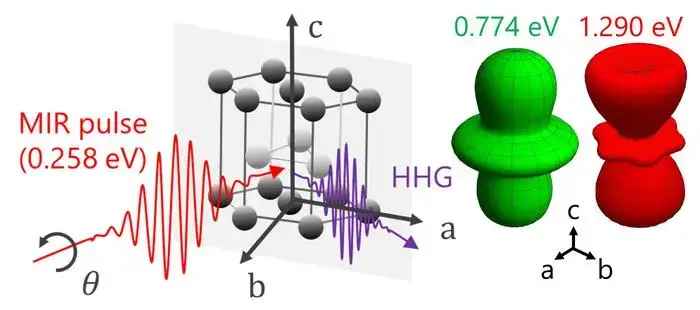A research team from Yokohama National University has recently published a groundbreaking study in Communications Physics, shedding light on how titanium’s subatomic characteristics influence its unique physical properties. This discovery not only provides fresh perspectives for titanium alloy development but also offers significant insights into materials science.
Table of Contents
Titanium’s Characteristics and Challenges
Titanium is widely valued for its exceptional corrosion resistance, lightweight properties, and high strength-to-weight ratio, making it a critical material in aerospace, precision manufacturing, and medical applications. Its biocompatibility further extends its use to implants, prosthetics, and artificial bones. However, the correlation between titanium’s internal electronic behavior and its physical attributes has long eluded researchers, posing a major challenge in material science.
High Harmonic Generation: Breaking Research Barriers
The research team leveraged High Harmonic Generation (HHG), a technique that addresses the limitations of conventional methods. HHG occurs when intense infrared laser pulses interact with a material’s surface, causing its internal electrons to emit light signals at frequencies much higher than the laser itself. Professor Ikufumi Katayama from Yokohama National University’s School of Engineering explained: “When strong infrared laser pulses strike a material, the electron dynamics transform into high-frequency optical signals. These signals allow us to analyze how electrons move and bond within the material.”

Generating high harmonics from metals like titanium is notoriously difficult due to the shielding effect. This effect arises when free electrons in the metal interact strongly with the laser field, hindering data collection. According to Professor Katayama: “Through meticulous adjustments of the laser setup, we successfully minimized the shielding effect, enabling us to observe titanium’s electronic structure clearly for the first time.”
Electron Behavior and Titanium’s Physical Properties
Through a combination of computer simulations and experimental methods, the research team uncovered how titanium’s electronic behavior impacts its physical properties. The study revealed that titanium’s unique characteristics stem from its uniaxial structure and the way electrons move within its energy bands, which directly influence its mechanical properties. Specifically, titanium’s strength and toughness vary depending on the direction of applied force, correlating with the motion and bonding of electrons along different orientations.
The alignment of the laser and titanium atoms plays a critical role in electron movement and bonding. The findings showed that electron transitions between energy bands alter the strength of titanium’s bonds, thus affecting its toughness and flexibility. “This insight helps explain why titanium exhibits varying mechanical properties under different conditions,” said Professor Ikufumi Katayama.
Future Applications and Prospects
Dr. Tetsuya Matsunaga from the Japan Aerospace Exploration Agency (JAXA) highlighted that this research paves the way for designing stronger and more efficient titanium alloys. With this novel approach, scientists can accurately map the relationship between titanium’s internal structure and its performance, enabling the creation of competitive materials for use in aerospace, medical, and manufacturing industries.
As this research progresses, it will help optimize titanium’s properties further and explore its potential applications in emerging technologies. These include high-efficiency energy devices and next-generation infrastructure materials. Titanium research is ushering in a new era in materials science, injecting fresh vitality into human technological advancement.
References:
- Scientists Crack the Code of Titanium’s Strength and Flexibility
- Ikufumi Katayama, Kento Uchida, Kimika Takashina, Akari Kishioka, Misa Kaiho, Satoshi Kusaba, Ryo Tamaki, Ken-ichi Shudo, Masahiro Kitajima, Thien Duc Ngo, Tadaaki Nagao, Jun Takeda, Koichiro Tanaka, Tetsuya Matsunaga. (2024) Three-dimensional bonding anisotropy of bulk hexagonal metal titanium demonstrated by high harmonic generation, Communications Physics, 7, 1-7.
- Scientists solve the mystery of titanium’s strength and toughness
(Source of the first picture: Wikipedia)
We offer customized adjustments to the grinding process, tailored to meet processing requirements for maximum efficiency.
Feel free to contact us and we will have specialist available to answer your questions.
If you need customized quotations, you’re also welcome to contact us.
Customer Service Hours: Monday to Friday 09:00~18:00 (GMT+8)
Phone: +8867 223 1058
If you have a subject that you want to know or a phone call that is not clear, you are welcome to send a private message to Facebook~~
Honway Facebook: https://www.facebook.com/honwaygroup
You may be interested in…
- Polishing Material and Corresponding Abrasive Organizer Table
- Lanthanum Carbonate: A Rare Earth Material from Medicine to Industry
- Holmium: Wielding Immense Power, It Obliterates Kidney Stones
- Grinding and Polishing Consumables
- Nanodiamonds Create a New Revolution for a Cool Summer: Developing New Cooling Fabrics to Help You Easily Survive the El Niño Heatwave!
